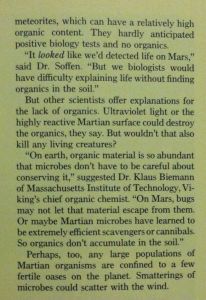By: Nicole Willett
 On December 16, 2014 at the American Geophysical Union conference in San Francisco, a panel of scientists working on the Mars Science Laboratory (MSL) Curiosity Rover data announced what we have all been waiting decades to hear. John Grotzinger stated unequivocally, “…there is methane occasionally present in the atmosphere of Mars and there are organics preserved in (…) rocks on Mars.”
On December 16, 2014 at the American Geophysical Union conference in San Francisco, a panel of scientists working on the Mars Science Laboratory (MSL) Curiosity Rover data announced what we have all been waiting decades to hear. John Grotzinger stated unequivocally, “…there is methane occasionally present in the atmosphere of Mars and there are organics preserved in (…) rocks on Mars.”
Why is this important? All life on Earth that we have discovered so far is carbon based, aka organic. Carbon is found in the DNA of all life forms on Earth. Carbon can bind with many other elements to form thousands of molecules that are involved in biological processes. Needless to say, finding organics and methane is a game changer for all of science, from astronomy to zoology. Organics in general refer to molecules that are often found as components of life. We know from studying life forms on Earth that methane is a common organic molecule that is a waste product of bacteria and macro organisms. In fact approximately 90% of Earth’s methane has a biological origin. However, about 10% of methane on Earth is a result of geological activity. According to author Jeffrey Bennett from the University of Colorado, Boulder, “The amount of methane in the atmosphere appears to vary regionally across Mars, and also seems to vary with the Martian seasons. This has led some scientists to favor a biological origin (…)if the source is volcanic (…) the amount of (…)heat necessary for methane release [could] be sufficient to maintain pockets of liquid water underground.” Pockets of liquid water would be conducive to life.
 The Earth and Mars have many similarities including a 24 hour and 24 hour 37 minute day respectively, a similar axial tilt causing seasons to occur, a rocky surface with many of the same types of rocks and minerals (which may be used as a source of energy), volcanic activity and hydrothermal vents past and/or present, water that is/was fresh, salty, acidic, and/or basic. Now and perhaps most important of all, organic matter and methane. In addition to the aforementioned facts, the fleet of rovers and orbiters that have arrived at Mars have proven an environment conducive to microorganisms existed and may currently exist on the Red Planet. We know this thanks to the many spacecraft that have visited Mars and sent back ample amounts of data.
The Earth and Mars have many similarities including a 24 hour and 24 hour 37 minute day respectively, a similar axial tilt causing seasons to occur, a rocky surface with many of the same types of rocks and minerals (which may be used as a source of energy), volcanic activity and hydrothermal vents past and/or present, water that is/was fresh, salty, acidic, and/or basic. Now and perhaps most important of all, organic matter and methane. In addition to the aforementioned facts, the fleet of rovers and orbiters that have arrived at Mars have proven an environment conducive to microorganisms existed and may currently exist on the Red Planet. We know this thanks to the many spacecraft that have visited Mars and sent back ample amounts of data.
 The Viking missions were sent to Mars in the mid 1970’s. They carried a variety of scientific instruments. Some of them sampled the atmosphere and some examined the regolith. The results of these experiments have been studied repeatedly since they were performed. The Labeled Release Experiment, designed by Dr. Gil Levin, made a controversial and still contested discovery of life on Mars. Viking also discovered methane at 10.5 parts per billion (ppb) in 1976. It seems both of these discoveries were discounted over the past four decades.
The Viking missions were sent to Mars in the mid 1970’s. They carried a variety of scientific instruments. Some of them sampled the atmosphere and some examined the regolith. The results of these experiments have been studied repeatedly since they were performed. The Labeled Release Experiment, designed by Dr. Gil Levin, made a controversial and still contested discovery of life on Mars. Viking also discovered methane at 10.5 parts per billion (ppb) in 1976. It seems both of these discoveries were discounted over the past four decades.
While utilizing the NASA Infrared Telescope in Hawaii, Michael Mumma, of NASA Goddard, observed methane using ground based instrumentation in 2003. When he followed up the observations in 2006, the methane had vanished. Some scientists have stated that is indicative of a seasonal plume. According to NASA’s astrobiology website Mumma and his team observed 20-60 ppb of methane near the poles and up to 250 ppb near the equator. It is interesting to note that the levels of methane are significantly higher near the equator where the temperature is higher and possibly more conducive to life.
 A decade ago the European Space Agency (ESA) announced they had discovered plumes of seasonal methane on Mars. In March of 2004, ESA announced that the Planetary Fourier Spectrometer on Mars Express detected about 10 ppb of methane in the Martian atmosphere. A spectrometer is a device that “looks” at a sample of something, in this case atmospheric gases, and takes reading(s) to determine what molecules make up the sample being observed. A computer generated graph of some type is then read by scientists to analyze the spectral data.
A decade ago the European Space Agency (ESA) announced they had discovered plumes of seasonal methane on Mars. In March of 2004, ESA announced that the Planetary Fourier Spectrometer on Mars Express detected about 10 ppb of methane in the Martian atmosphere. A spectrometer is a device that “looks” at a sample of something, in this case atmospheric gases, and takes reading(s) to determine what molecules make up the sample being observed. A computer generated graph of some type is then read by scientists to analyze the spectral data.
Although ESA and NASA themselves had previously detected methane on Mars, it was important to for NASA to continue the search, using the MSL Curiosity, on the ground in order to again verify the results. The public may get frustrated with the continuous “discoveries” of methane, but science is always retesting results to essentially try to “disprove” itself in order to make sure the facts are real. The Curiosity Rover landed on Mars in August of 2012. It seemed that almost as soon as the Curiosity Rover started exploring her new home on Mars she discovered a dry riverbed where fresh water once flowed in Gale crater. When she drilled into the rock dubbed “John Klein” scientists realized that the rock contained what biologists call CHNOPS. That acronym stands for Carbon, Hydrogen, Nitrogen, Oxygen, Phosphorus, and Sulfur. Those are the six elements needed for all life on Earth to exist. Another discovery were molecules that included carbon which scientists called “simple organics”. The most recent and most important discovery includes more complex organic molecules than previously discovered, such as methane and chlorobenzene. We know Mars is enriched with all of the same chemicals to make life that the Earth has. This latest and greatest discovery puts to rest the long debate about whether Mars has organics. Some scientists and laymen have been vehemently denying that it is possible. For the community of “believers” in Martian organics, we feel  vindicated.
vindicated.
The amount of methane reported over the past forty years on the Red Planet ranges from 5-250 ppb from a variety of sources, NASA, ESA, orbiters, rovers, and ground based Earth telescopes. Many peer reviewed scientific journal articles have been published regarding Martian methane and the possible explanations for its existence. Some of the potential sources of methane include the presence of life, volcanoes, hydrothermal vents, and several other geological processes. Methane breaks up and only has a lifespan of several decades to 300 years, which is a short time on a planetary scale. It then breaks down into water and carbon dioxide. That being said, since methane is present on Mars, it must be getting replenished biologically or geologically currently.
Over the last few decades scientists have discovered amino acids in comets and meteorites, which we know slam into planets, so it is common sense to see that whether Mars originally had organics or not that organics would have landed there sometime in the last 4.5 billion years. In 2012 it was announced that even Mercury has organics on its surface. The moon Enceladus, orbiting Saturn, has organics spewing out of the ice covered surface from the salty ocean below. It seems that everywhere we look we find organics. We must ask ourselves, how easy is it to form organics and life? Is life everywhere?
 “[A] striking aspect of the Curiosity discovery is that the concentration of methane detected varies sharply over time. That can only be the case if the source of the methane is locally concentrated, as a globally spread source could not cause such sharp variations. Thus, there may be a patch of ground relatively close to Curiosity which is the source of the emissions, and, therefore, a prime target to drill in an attempt to find subsurface life. Similar biologically suspect spots may well exist elsewhere. We need to locate such spots, and then send human explorers to drill and find out what lies beneath,” states Dr. Robert Zubrin, President of the Mars Society.
“[A] striking aspect of the Curiosity discovery is that the concentration of methane detected varies sharply over time. That can only be the case if the source of the methane is locally concentrated, as a globally spread source could not cause such sharp variations. Thus, there may be a patch of ground relatively close to Curiosity which is the source of the emissions, and, therefore, a prime target to drill in an attempt to find subsurface life. Similar biologically suspect spots may well exist elsewhere. We need to locate such spots, and then send human explorers to drill and find out what lies beneath,” states Dr. Robert Zubrin, President of the Mars Society.
~Humans to Mars as a bridge to the stars
[Images: drsusanrubin.com, NASA, NatGeo, ESA, NASA, TMS]
Note: The article snip above is from the Jan 1977 National Geographic magazine. Below are the next few paragraphs.




















